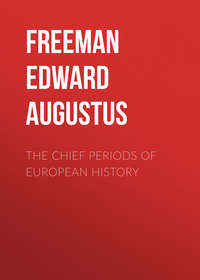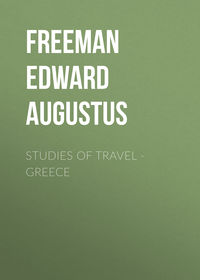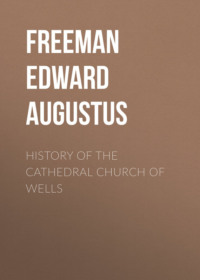 полная версия
полная версияStudies of Travel: Italy

Edward A. Freeman
Studies of Travel: Italy
Arezzo
The city of Mæcenas, and of a whole crowd of famous men of later times, shows no outward signs of being much frequented by travellers. There is some difficulty there in getting so much as an Italian newspaper, and, though excellent photographs have been taken of some of the chief buildings, they must be sought for at Florence; they are not to be bought at Arezzo. Yet the old Etruscan city has many attractions, among them surely the singular cleanness of its streets, and, above all, that clear and pure air which is thought to have had something to do with nourishing the genius of so many of its citizens in so many different ways. Perhaps, on the whole, Arezzo does not suffer from not having yet put on the cosmopolitan character of some of its neighbours. And if the city does not, either as Arretium or as Arezzo, stand forth in the first rank of Italian cities, still it has a long history under both forms of its name. If, again, its buildings do not rank with those of Pisa or Lucca, still there is quite enough both in the general aspect of the city, and in some particular objects within its walls, to claim a day or two's sojourn from any one who is not eager to rush from Florence to Rome as fast as the so-called express train can carry him.
Arezzo, as to its physical site, holds a middle position between cities which sit perched on a high hill-top like Fiesole, and cities which, like Florence, lie flat or nearly so on the banks of a great river. It has its river, if we may give that name to the mere brook which presently loses itself in the Chiana, as the Chiana soon loses itself in the Arno. The river too has a bridge, but both river and bridge have to be sought for; they form no important points in the general aspect of the city. The bridge at Arezzo is not one of those to which we instinctively go the first thing to take a general view of the city as a whole. The hill is a more real thing, as any one will say who climbs some of its steeper streets. Still it is one of those hills which seem to borrow height and steepness from the fact of being built upon. If it were covered with green grass, it would simply pass as one of several small hills which break the flat of the rich plain, girded in on all sides by higher mountains, which rise, in February at least, into vast snowy heights in the further distance. Still Arezzo has distinctly the character of a hill city, not of a river city; the hill counts for a good deal, while the river counts for nothing. The best points for a general view from below will be found on the town wall, a little way to the left of the railway station; while to look down on Arezzo we must climb to the castle in the eastern corner of the city, whose Medicean fortifications look strong enough without, but which, within, has gardens and fig trees level with the walls, and rabbits running about at large among them. The castle therefore forms no special object in the general view; it simply passes as a more marked part of the line of the city walls. These last remain in their whole circuit, except where they have been broken down to make the approach to the railway; surely a new gate would have been a better way of compassing this object. A town wall standing free, as those of Arezzo stand in nearly their whole range, is always a striking object, and one whose circuit it is pleasant and instructive to make. And it has a special interest in some cities, of which Arezzo is one, which have, so to speak, a show side. One side lies open to the world; the ancient roads, the modern railway, approach it; the city dies away into the country by gradually descending suburbs. On the other side, the wall suddenly parts the inhabited town, sometimes from actual desolation, at all events from open fields; the hill rises sheer above whatever lies beyond it. So it is with the north-eastern side of Arezzo, if we go behind the cathedral and the castle; we have not fully taken in the lie of the city without taking this walk to its rear. Still we must not look to the walls of Arezzo for the special interest of some other walls. They will not give us either Roman or Etruscan blocks, nor yet the picturesque outline of mediæval towers and gateways. The walls put on their present aspect in Medicean times, and over one of the gates we see an inscription which illustrates one stage of a tyrant's progress. The first avowed sovereign Cosmo appears as "Duke of Florence and Siena." He had inherited one enslaved commonwealth; he had himself enslaved another; meanwhile he was waiting for the fitting reward of such exploits in the higher rank and more sounding title of a Grand Duke of Tuscany.
In the general view of Arezzo there can be hardly said to be any one dominant object. If the castle made any show, it and the cathedral church, standing nearly on the same level on the highest ground in the town, would stand well side by side. As it is, the body of the duomo is the prominent feature in the view. But it is hardly a dominant feature. It is the only building whose body shows itself, but it rises among a crowd of towers, ecclesiastical and municipal, and one of them, the great campanile of St. Mary della Pieve, though the body of its church does not show itself far below, is a distinct rival to the cathedral, and utterly dwarfs its small and modern, though not ungraceful, octagon tower. These two churches form the two greatest architectural objects in Arezzo. The municipal element does not show itself so largely as might be looked for. The town-house is there, and the town-tower, and that hard by the duomo; but they do not hold, even comparatively, anything like the same position as their fellows in the great Florentine piazza. Perhaps this is not wonderful in a city which was so largely Ghibelin, and whose most noted historical character was a fighting bishop. Guy Tarlati, bishop and lord of Arezzo, keeps – though not on its old site – his splendid tomb in the duomo, on which are graven the names and likenesses of the castles which he won, and how King Lewis of Bavaria took the Lombard crown at his hands. But Arezzo has little or nothing to show in the way of houses or palaces or of street arcades. Its most striking building besides the churches is the front of that called the Fraternità dei Laici, in the open sloping space which seems to mark the forum of Arretium. This is a work in the mixed style of the fourteenth century, but so rich and graceful in its detail as to disarm criticism. Within, it contains the public library and museum. This last has much to show in many ways; most striking of all, because thoroughly local, are the huge tusks and other remains of the fossil elephants and other vast beasts of bygone days. The valley of the Chiana is full of them. Naturally enough, in the early days of science, when elephants' bones were no longer thought to be those of giants, they were set down as relics of the Gætulian beasts of Hannibal.
Something may be picked up here and there in the other churches of Arezzo; but it is Santa Maria della Pieve which is the real object of study. The duomo is absolutely without outline; it is a single body with nothing to break it, and nothing to finish it at either end. But its proportions within come somewhat nearer to Northern ideas than is common in the Italian Gothic, and its apse specially reveals the German hand to which tradition attributes the building. The church of La Pieve is of a higher order. It has real shape within and without. Its four arms should support a cupola, only the cupola has never been finished; the apse is in the very best form of the Italian Romanesque; the west front is called a copy of Pisa; but neither its merits nor its defects seem borrowed from that model. Part of it is sham, which nothing at Pisa is, while the small arcades stand out free, as at Lucca, but not at Pisa. The front is a wonderful display of column capitals of all kinds, from the Corinthian column used up again in its lowest range to the fantastic devices of the small ranges above them. The arch and the entablature are both used; so they are in the apse: so they are within. For the choir has a real triforium, and that triforium shows this strange falling back on the construction of the Greek. The arches below are round; those which should support the cupola, as well as those of the nave, are pointed, the latter rising from columns of prodigious height. The internal effect is like nothing else; it is quite un-Italian; it is as little like anything English or French; the arches, but not the columns, suggest the memory of Aquitaine. The south side has been rebuilt. Perhaps the work was physically needful: but it has involved the destruction of the substructure of the ancient building on the site of which the church stands. The columns in the west front seem to be the only remains of Arretium as distinguished from Arezzo. The "Tyrrhena regum progenies" have here left but small traces behind them.
Cortona
From Arezzo the next stage will naturally be to the hill on whose height
… Cortona lifts to heavenHer diadem of towers.If the journey be made on a market or fair day, the space between the walls and the station at Arezzo may be seen crowded with white oxen, suggesting the thought of triumphs and triumphal sacrifices. Their race, it was said, prayed to the gods that Marcus and Julian might not win victories which would lead to their destruction. And the prayer seems to have been answered, as the breed specially connected with Clitumnus has clearly not died out, even by the banks of Clanis. The journey is not a long one; yet, if we had time to see everything, we might well wish to break it, as we pass by the hill of Castiglione Fiorentino, with its walls and towers. That strong and stern hill-fortress comes in well between Arezzo and Cortona. Arezzo covers a hill, but it can hardly be said to stand on a hill-top; Castiglione distinctly does stand on a hill-top; Cortona sits enthroned on a height which it would hardly be straining language to speak of as a mountain. We have now come to a site of the oldest class, the stronghold on the height, like Akrokorinthos and the Larissa of Argos. But at Argos and Corinth the mountain-fortress became, at a later stage, the citadel of the younger city which grew up at the mountain's foot. But at Cortona, as at greater Perugia, the city still abides on the height; it has never come down into the plain. So it has remained at Laon; so it has become at Girgenti, where the vast lower space of the later Akragas is forsaken, and the modern town has shrunk up within the lines of the ancient acropolis. From the ground below Cortona we look up to a city like those of old, great and fenced up to heaven; the "diadem of towers" is there still, though it is now made up of a group of towers, ecclesiastical, municipal, and military, none of them of any account in itself, but each of which joins with its fellows to make up an effective whole. At Cortona indeed, as at Argos and Corinth, there is an upper and a lower city, and the upper city is pretty well forsaken. But while at Argos and Corinth the lower city stands in the plain, and the acropolis soars far above it, at Cortona the lower city itself stands so high up the hill that it is only when we reach it that we fully understand that there is a higher city still. The site itself belongs so thoroughly to the oldest days of our European world that there is a certain kind of satisfaction in finding that the main interest of the place belongs to those oldest days. We are well pleased that everything of later times is of quite a secondary character, and that the distinctive character of Cortona is to be the city of the Etruscan walls.
In truth, a certain degree of wonder is awakened by the fact that Cortona exists at all. It would have been by no means amazing if we had found only its ruins, as on so many other old-world sites for which later times have found no use. Great in its earliest days, foremost among the Etruscan cities of the mountains, Cortona has never been great in any later age. As a Roman city and colony it was of so little account that, even in Italy, where bishops are so thick upon the ground, it did not become a bishopric till the fourteenth century. Just at that time came its short period of anything like importance among the cities of mediæval Italy. Sold to Florence early in the fifteenth century, it has ever since followed the fortunes of the ruling city. Yet through all these changes Cortona has managed to live on, though we can hardly say to flourish. It still keeps the character of a city, though a small and mean one, inhabited by a race of whom the younger sort seem to have nothing to do but to run after the occasional visitor. One ragged urchin offers to accompany him to the cathedral; another persists in following him round nearly the whole circuit of the ancient walls. This last is too bad; a walk round the walls of Cortona is emphatically one of those things which are best enjoyed in one's own company.
As an Italian city which has lived, though in rather a feeble way, through the regular stages of Roman colony and mediæval commonwealth, Cortona has of course its monuments which record those periods of its being. There are some small fragments of Roman work, but nothing that can be called a Roman building. There is a crowd of churches and monasteries, but none of any great architectural value, though some contain works of importance in the history of painting. It perhaps marks the position of Cortona as a comparatively modern bishopric that its cathedral church is in no sort the crowning building of the city. The duomo stands about half-way up the height within the town, on a corner of the walls. Its elegant Renaissance interior has been already spoken of; it seems to have supplanted a Romanesque building the columns of which may have been used again. The point in the upper city where we should have looked for the duomo is occupied by the Church of St. Margaret, that is, Margaret of Cortona, described over her portal as "pœnitens Margarita," marked off thereby alike from the virgin of Antioch and from the matron of Scotland. The municipal buildings are not remarkable, though one wall of the Palazzo Pretorio must be a treasure-house for students of Italian heraldry, thickly coated as it is with the arms of successive podestas. Of private palaces the steep and narrow streets contain one or two; but it is not on its street architecture that Cortona can rest its claim to fame. From the lower city, with its labyrinth of streets, we may climb to the acropolis. Here, around the Church of St. Margaret, all seems desolate. The Franciscan convent on the slope below it lies in ruins – not an usual state for an Italian building. The castle above, fenced in by its ditch, seems as desolate as everything around, save the new or renewed fabric of St. Margaret's. This height is the point of view to which the visitor to Cortona will be first taken, if he listens to local importunity. A noble outlook it is; but the traveller can find points of view equally noble in the course of the work which should be done first of all – that of compassing the mighty wall which is the thing that makes Cortona what it is.
The process of going to the back of the city, which may be done in some measure at Arezzo, may be done in all its fulness at Cortona. Happily, very nearly the whole wall can be compassed without, and in by far the greater part of its course more or less of the old Etruscan rampart remains. In many places the mighty stones still stand to no small height, patched of course and raised with work of later times, but still standing firmly fixed as they were laid when Cortona stood in the first rank among the cities of the Rasena. Not that there is reason to attribute any amazing antiquity to these walls. We must remember that the Etruscan cities kept their local freedom till the days of Sulla, and that some Etruscan works are later than some Roman works. The masonry is by no means of the rough and early kind; yet the one remaining gate, unluckily blocked, is square-headed, and might almost have stood at Mykênê. On the highest point, the hindermost point, the wildest and most desolate point, where, though just outside an inhabited city, we feel as if we were in a land forsaken of men, the Etruscan wall has largely given way to the mediæval fortress whose present aspect dates from Medicean days. But it has given way only to leave one of the grandest pieces of the whole wall standing as an outpost in the rear of the city, overhanging the steepest point of the whole hill. The Etruscan wall, the Medicean castle, one seeming to stand as forsaken and useless as the other, form a summary of the history of Cortona in stone and brick.
From the walls we may well turn to the Museum, to see the tombs and the other relics of the men who reared them. Pre-eminent among them, the glory of the Cortonese collection, as the Chimæra is the glory of the Florentine collection, is a magnificent bronze lamp, wrought with endless mythological figures. Near it stands the painting of a female head, which we might at first take for the work of Renaissance hands, and in which those who are skilled in such matters profess to recognize the existing type of Cortonese beauty. The painting however dates from the days when Cortona was still Etruscan. Perugia keeps her ancient inhabitants themselves, in the shape at least of their skulls and skeletons. At Cortona the remote mothers, it may be, of her present people live more vividly in the form of the Muse whose features were copied, it may be nineteen hundred years back, from the living countenance of one of them.
Perugia
The hill-city of Perugia supplies an instructive contrast with the hill-city of Cortona. The obvious contrast in the matter of modern prosperity and importance is an essential part of the comparative history. Cortona has through all ages lived on, but not much more than lived on. Perugia has, through all ages, kept, if not a place in the first rank of Italian cities, yet at any rate a high place in the second rank. She never had the European importance of Venice, Genoa, Florence, Naples, and Milan, or of Pisa in her great days. But in the purely Italian history of all ages Perugia keeps herself before our eyes, as a city of mark, from the wars of the growing Roman commonwealth down to the struggle which in our own days freed her from a second Roman yoke. In the civil wars of the old Rome, in the wars between the Goth and the New Rome, in the long tale of the troubled greatness of mediæval Italy, Etruscan Perusia, Roman Augusta Perusia, mediæval and modern Perugia, holds no mean place. And the last act in the long drama is not the least notable. It sounds like a bit out of Plutarch's "Life of Timoleôn," when we read or when we remember how, twice within our own days, little more than twenty and thirty years back, the fortress of the tyrants was swept away, as the great symbolic act which crowned the winning back of freedom in its newest form. When a city has such a tale as this to tell, we do not expect, we do not wish, that its only or its chief interest should gather round the monuments of an early and almost præhistoric day of greatness. At Cortona we are glad that things Etruscan are undoubtedly uppermost. At Perugia we are glad that things Etruscan are there to be seen in abundance; but we also welcome the monuments of Roman days, pagan and Christian; we welcome the streets, the churches, and palaces of mediæval times, and even the works of recent times indeed. The Place of Victor Emmanuel with the modern buildings which crown it, supplanting the fortress of Pope Paul, as that supplanted the houses, churches, and palaces of earlier times, is as much a part of the history of Perugia as the Arch of Augustus or the Etruscan wall itself.
The difference between the abiding greatness of Perugia and the abiding littleness of Cortona is no doubt largely due to the physical difference of their sites. Both are hill-cities, mountain-cities, if we will; but they sit upon hills of quite different kinds. The hill of Perugia is better fitted for growth than the hill of Cortona. Cortona sits on a single hill-top. Perugia sits, not indeed on seven hills, but on a hill of complicated outline, which throws out several – possibly seven – outlying, mostly lower, spurs, with deep valleys between them. The Etruscan and Roman city took in only the central height, itself of a very irregular shape and at some points very narrow. The lower and outlying spurs were taken within the city in later times. Hence it is only in a small part of their circuit that the original walls remain the present external walls; it is only on part of its western side that we can at all go behind Perugia. But the lower city is still thoroughly a hill-city. The hill of Perugia is lower than the hill of Cortona, while the city of Perugia is vastly greater than the city of Cortona. But Perugia is as far removed as Cortona from coming down into the plain. On the little hill of Arezzo such a process could happen, and it has happened. Not so with the loftier seats of its neighbours. Cortona is not likely to grow; Perugia very likely may. But it will take a long period of downward growth before unbroken dwellings of men stretch all the way from its railway station to its municipal palace.
At Perugia, as becomes its history, no one class of monuments draws to itself exclusive, or even predominant, attention. Perhaps, on the whole, the municipal element is the most striking. The vast pile of the public palace, its grand portal, its bold ranges of windows, its worthy satellites, the Exchange, and the great fountain with its marvels of sculpture, utterly outdo, as the central points of the city, the lofty but shapeless and unfinished cathedral which stands opposite to them. And at this point, the Church and the commonwealth are the only rivals; the remains of earlier times do not come into view. For them we must seek, but at no great distance. Go down from the central height, and stand on the bridge which spans the Via Appia of Perugia, a strange namesake for the Via Appia of Rome. There the walls of the Etruscan city, rising on the one side above the houses, on the other above one of the deep valleys, form the main feature. And, if they lose in effect from the modern houses built upon them, the very incongruity has a kind of attractiveness, as binding the two ends of the story together. From this point of view, Perugia is specially Perugian. And, if the walls are less perfect than those of Cortona, they have something that Cortona has not. The Arch of Augustus, the barrier between the older and the newer city, spans the steep and narrow street fittingly known as Via Vecchia. At Perugia the name of Augustus suggests the thought whether he really made the bloody sacrifice to the manes of his uncle with which some reports charge him. The gate at least makes no answer, save that we see that the Roman built on the foundations of the Etruscan, save that the legend of "Augusta Perusia" is itself a record of destruction and revival. The gateway, tall, narrow, gloomy, the Roman arch springing from two vast Etruscan towers, is a contrast indeed to such strictly architectural designs as the two gates of Autun. The Roman builder was evidently cramped by the presence of the older work. In fact the general character of the gateway has more in common with the endless mediæval gateways and arches which span the streets of Perugia. Of really better design, though blocked and in a less favourable position, is the other gateway, the Porta Martis, which now makes part of the substructure of the new piazza, as it once did of that of the papal fortress. And he who looks curiously will find out, not indeed any more Roman gateways, but the jambs from which at least two other arches, either Roman or Etruscan, once sprang.
The walls and gateways of a city can hardly be called its skeleton, but they are in some sort its shell. And at Perugia the body within the shell was of no mean kind. Take away every great public building, church, or palace, and Perugia itself, its mere streets and houses, would have a great deal to show. With no grand street arcades like Bologna, few or no striking private palaces like Venice and Verona, Perugia once had streets after streets – the small and narrow streets not the least conspicuously – of a thoroughly good and simple style of street architecture. Arched doors and arched windows are all, and they are quite enough. Some are round, some are pointed; some are of brick, some of stone; and those of brick with round arches are decidedly the best. But never were buildings more mercilessly spoiled than the Perugian houses. As in England mediæval houses are spoiled to make bigger windows, so at Perugia they are spoiled to make smaller windows. Most of the doorways and windows are cut through and blocked, and an ugly square hole is bored to do the duty of the artistic feature which is destroyed. No land has more to show in the way of various forms of beauty than Italy; but when an Italian does go in for ugliness he beats all other nations in carrying out his object.







